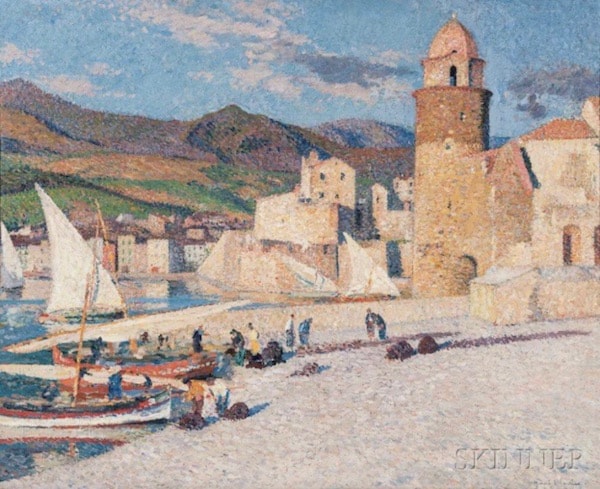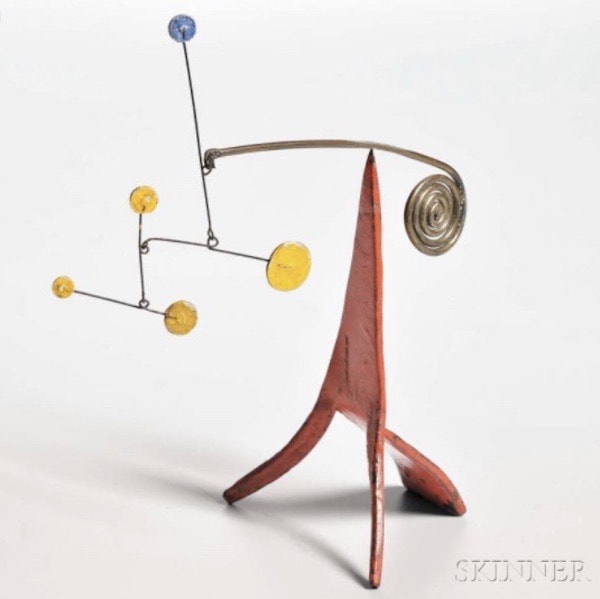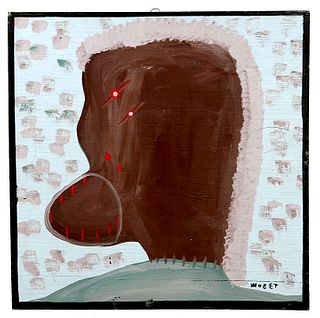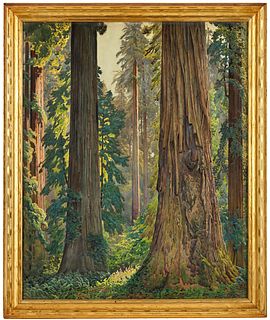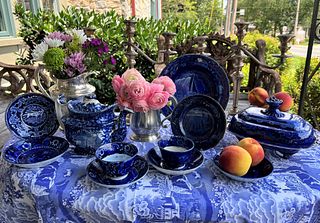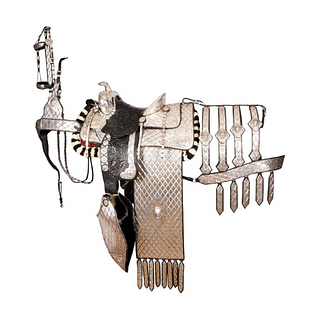Contemporary Knots and Passionate Portraiture: Selections from Skinner Auctions
Whether it rotates around a metal axis or hangs heavily on a wire, is made up of thousands of painted dots or only a handful of gestural strokes; this selection of artworks all exist in their individual glory, as well as a dynamic group of diverse styles, time periods and artistic introspection.
Skinner Auctions upcoming Fine Paintings & Sculpture sale on January 27 includes important Russian paintings, 17th and 18th Century Dutch works, 19th-Century American Landscapes, 20th-Century as well as Modern and Contemporary art. The following selection reflects the spirit of this catalog and its spectrum of distinguished artists.
Henri-Jean Guillaume Martin, Tour de Collioure, Oil on canvas, C. 1920
A mass of small, visible brush strokes dance around the landscape like a harmonious school of swimming sardines; Henri-Jean Guillaume depicts a mid-day scene of docking white sailboats, where changing postures of men cast plum-colored shadows on the bright sand of the village of Collioure, France. This charming, confident canvas is a manifestation of the works Martin painted after he moved away from Paris in 1900 and back to his birth-region of southern France. Martin wraps the distant peaks of the Pyrenees in hues of violet, cobalt-green and deep-indigo against a comforting blue sky. The tower of the church of Notre-Dame-des Anges, which served as both a lighthouse and a bell tower, sits solidly to the right of the composition attracting both hot and muted autumnal tones. Martin’s Post-Impressionistic style is a blend and culmination of his time spent in Italy painting with artists Edmond Aman-Jean and Ernest Laurent who were experimenting with the pointillist painting technique utilized by their close friend George Seurat.
Lot 440. Alexander Calder, Untitled (Standing Mobile) Sheet metal, brass, wire and paint, C. 1965
Straight out of the tube. The primary colored tokens of yellow, blue and red that adorn this petite mobile by Alexander Calder appears to have been playfully composed by a youngster, rearranging planetary constellations. However, it is the careful precision of a mechanical engineer that balanced these shapes by using wires and weighted tokens. By the time this particular standing mobile was constructed, Alexander Calder had established a successful artistic career on the international stage. Although his commissions during this time were large-scale, he didn’t downplay the importance of his tabletop sculptures. Swirling discs and floating geometric shapes pivot and bow when gently instructed by air currents, enabling innocent interactions between all those who encounter these sturdy yet carefree mobiles.
Lot 403. Philippe Maliavine, Baba (Winter) Oil on Canvas
A peasant woman is placed deliberately in the foreground like a defiant wall, enveloped by a glorious golden cloak; a clear and profound statement of protection and resilience against the brutal Russian winter. However, it isn’t just the pyramid of cloth that arrests the composition, her exposed, gentle edged face holds you captive, like spotting a rare Siberian eagle in the wild. This choice in composition runs parallel with Philippe Maliavine’s story as one of the leading Russian painters of the early 20th century. As a child, Maliavines first introduction to art was by the traveling monks who brought gilded boards of Russian icon paintings to his impoverished village of Kazanka. His choice to paint colorful, healthy renderings of peasants void of any “realistic” hardships and oppression sparked a deep distain from his art critics. Fortunately for us, he left behind a legacy of beloved portraits, painted with an idealistic spirit of broad strokes and blocks of color; for why shouldn’t those surviving the harshest of circumstances not be rewarded with the boundless, elegance of portraiture?
Lot 404. Philippe Maliavine, Russian Peasants Singing, Oil on canvas, 1899
This dipiction of Russian peasants locking hands and singing is yet another example of Maliavine’s expressive, painterly spirit. His controlled palette of toxic Fauvist greens, yellows and reds create a unique atmosphere where beams of pink bounce freely off of the textiles, tongues and cheeks of jubilant villagers.
There is an immediate juxtaposition when comparing the title of this piece to its appearance in texture and form. Flecks of sparkles and acrylic paint appear like small fragments of hope that remain on a deflated bow. By infusing feminist philosophies surrounding vanity and stereotypes into cotton bunting, Lynda Benglis produced a suprising, emotionally weighted series of "Sparkle Knot" sculptures. The tubular “Knot” form takes on bodily implications, like that of an organ or intertwined intestines which produces a purposeful anxiety and contributes a deep psychology toward the work. Her hallmark ability to inverse mediums by stuffing orbital sized gravity into faric and suspend thickly poured wax into the air like frozen magic, is what makes her a master of materials.
- Quilts as a 2025 Design Trend: A Celebration of American Heritage and Craftsmanship
- A Celebration of Sports History and Collectibles
- Antiques and the Arts Weekly Q&A: Allis Ghim
- The Thrill of Sports Memorabilia Auctions: A Collector’s Paradise
- Demystifying Coin Condition: A Guide to the Sheldon Grading Scale
- Snoopy & Friends: A “Peanuts” Auction at Revere
- Colorful Chinese Monochromes at Millea Bros
- 12 Holiday Gifts for the “Impossible to Buy For” on Bidsquare
- Alluring Art Objects and Accessories from the Estate of Chara Schreyer
- Kimball Sterling's One-Owner Outsider and Folk Art Collection Showcases Masters of the Unconventional



 EUR
EUR CAD
CAD AUD
AUD GBP
GBP MXN
MXN HKD
HKD CNY
CNY MYR
MYR SEK
SEK SGD
SGD CHF
CHF THB
THB